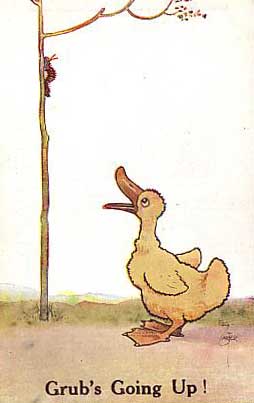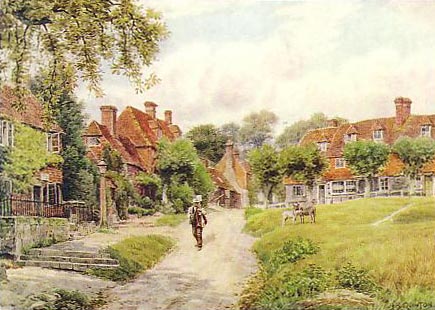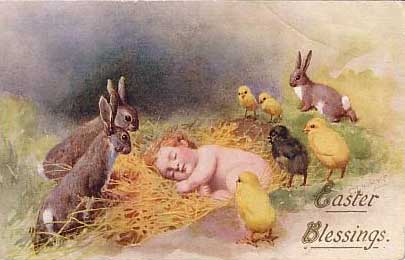APRIL 2011
SALMON POSTCARDS AND THEIR ARTISTS
and other publishers
 |
 |
 |
| Clovelly Bay |
Clovelly Bay |
Rose Cottage, Clovelly |
 |
 |
| The Shambles, York |
The Shambles, York |
 |
 |
 |
| London - Old Houses, Holborn |
Cliffords Inn |
St.Bartholomew the Great |
Do you like these eight postcards? Unfortunately the top five are not very popular but that does help them to sell very cheaply! In my search for every artist, series, etc. of Salmon cards I have a few of these. I sometimes look at my pencil sketch cards and think to myself those cards are just like a well-known Salmon artist's cards, I then look at what I thought was an original, see it wasn't and then wonder whether the artists were given a photograph to work from. But, in looking fairly carefully this does not seem to be the case. When you have a series of six you realise that it is possible to find that same six lightly coloured. The first two are not signed and the second two are signed by W.Jeffrey-Cook. The third picture is a photograph that the Pencil Sketch artist might have used to copy for his Clovelly cards. Then we have the two cards of York - exactly the same as each other until you see the embroidery on the second card. I have hunted high and low to find more cards which have similar embroidery which has been stuck on. Did the lady who bought the card think it looked far too plain and so did the embroidery herself "to cheer it up" which means I will never find another postcard treated like this one. Some of the cards have different words on the backs. The York cards have WITH GREETINGS AND BEST WISHES printed down the centre. Other artists names on Pencil Sketch cards are - Will Corbett and Vincent New.
The first five postcards are post WW2 so I was quite surprised in my search for more to find some of Frederick Ackland's cards and that he had done some of his own series. The last three cards are by him. The coloured one is No. 2943 and titled London - Old Houses, Holborn on the reverse. Then I found he had painted more in the style of the Pencil Sketch cards. The card titled Cliffords Inn is numbered b7151. On the reverse it reads - These buildings on the N.E. side of Cliffords Inn were erected about 1667. In some of the rooms the original panelling may still be seen. The third card is titled St. Bartholomew the Great, Smithfield and numbered b1754. On the reverse it reads - This early English Gateway leading to the Church of St. Bartholomew the Great. Through this doorway the martyrs were led who were burnt at the stake in Smithfield. This type of card is prefaced by a 'b' but gives no hint of a name for the series. Does anyone know how many could be found? The words Pencil Sketch are not mentioned so I wonder what words were used in the first half of the last century to describe this type of card? Do you know?!
George Parsons Norman. Just over a year ago I bought a modern postcard reprint published by J. Salmon and on the back it said Poppyland at Cromer from a painting by C.T. Howard, but I couldn't really believe it was by CTH. I looked in the book Picture Postcards and their Publishers by Anthony Byatt which answers lots of questions and it showed that Parsons Norman was known to the postcard world and postcards of the Norfolk area were printed by Salmon. I now have four more postcards and all are titled Poppyland on the reverse.. I had had thoughts about my original purchase being a Parsons Norman card but I hadn't realised he had some of his postcards published by Salmon. However, I now realise they are Fancy cards and I was looking in the wrong listing! The first card is the modern one saying it is by C.T.Howard and the next one to it is no.3978. The lower row contains no.3980 and 3981 for the last two. As you can see there is a Birthday verse by the well-known May Olney. Do you know if there are many more for me to find?
 |
 |
This modern card is one which I have had in my album for a number of years, just one small part of where we have lived for the last 25 years. We live at Locks Heath which is close to the River Hamble where it exits into the sea. About a mile inland from the sea there is a ferry which crosses from Warsash to a village (full of restaurants) named Hamble. A lot of people have used this ferry in the past. In the postcard the ferry is painted orange, currently it is pink and I can't remember what it was when we moved here. There is also a small hut for people to wait in if the weather is bad. More important is the man who has run the ferry for 50 years. He is 69 years old named Ray Sedgewick. Rarely do you wait long for the ferry to arrive. As soon as he sees a few people on the other side of the river from where he is off he goes. This card was published by Sheltie Cards of Surrey.
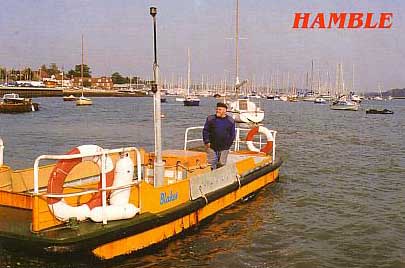 |
Next comes an article by Quintin Cullen.
During my last visit to Salmon of Sevenoaks I watched the 'up-dating' process where on a computer screen a card could be altered. In days gone by either the artist himself or a current member of the Salmon team altered what were presumably thought to be out of date elements and the card was re-issued, usually with its original number. This could be shortening of skirts, removal of people, extension to the pier, additional buildings and even geographical changes. What has always amazed me is that the 'art' work was frequently badly executed leaving 'ghosts' or deformed lower legs, vehicles that were unfit to drive etc. There was no doubt that this work was modernising the card and we call them up-dates.
The work I saw on the computer was not an up-date. It was replacing elements of a card with a piece of nostalgia. So you can find modern versions of old cards with people or animals of yesteryear. No ghosting these days because with the aid of a computer you can merge and resize objects perfectly and then adjust the colour much more accurately than could our earlier artists.
The first card is no.872 by A.R.Quinton. Next is the same view painted by A.R.Quinton before he joined Salmon, but not issued as a postcard until computer numbers. It is 14-01-71-94.
I have also noticed that pictures appearing in the recipe books are frequently not from the postcard archives. Indeed a number are by artists who never had any of their work published on postcards. Presumably they are out of copyright. I have also noticed some modern cards with updates of a slightly different nature. Until now I have been listing them as modern versions.
Santa Claus was as generous as always and I have a new book to read. Rural England COTTAGE and VILLAGE LIFE by P.H. Ditchfield. Colour plates and line drawings by A.R. Quinton. 52 colour plates and 19 line illustrations. It is hard back and runs to 185 pages plus. Reprinted in 1993. The less I say about the text and type setting the better but the A.R.Quinton pictures are superb.
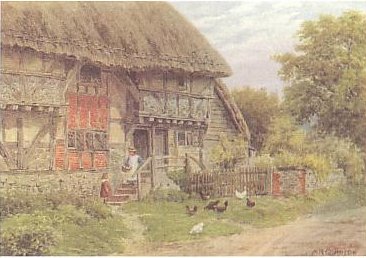 |
 |
| Old Cottage, Bignor, Sussex. |
Dossington, near Stratford-on-Avon |
Neither of these are in my postcard collection but Douglas Yelland tells me that they are both in Favourite Country Soup and Favourite Apple Recipes. When I looked them up I found no less than 9 other of the book's coloured plates between the 2 recipe books. Douglas also mentioned that Dossington should be spelt Dorsington!
I recognised half of the pictures from my postcard collection. BUT NOT QUITE. When I compare the pictures, all signed A.R.Quinton, with my collection they are not 1879, 1318, 1618, 1619, 1044, 1778, 3564, 1620, 1880, 1624, 1865, 1341, 1625, 1626, 1627, 1342, 3565, 3566 but something similar. When they are 14-01-71-94, 97, 98, 99 they are exactly as in the book. The book was first published in 1912 by which time A.R.Quinton was hardly settled at Salmon's and Ditchfield had finished his writing. J.M.Dent & Sons Ltd. were the original publishers and Bracken Books claim copyright 1993 for the revised edition.
Three of the plates are very similar to three of the 9535 series by Tuck.
Some of the 'modern' versions in my records have to be changed to 'Earlier' versions.
At this time we have two dates coming up. One is Mothering Sunday on April 3rd. Do you remember going to Sunday School and being given a posy of flowers to take home to your mother? This, over the years, has been superceded by Mother's Day and then Father's Day. I have only two cards to show you, both by C.T.Howard. One was specially ordered by the Mothers Union and the other is an overprint. Mothering Sunday has been celebrated in the UK on the fourth Sunday in Lent since at least the 16th century. It has been a day for giving thanks for all the things our mothers do for us.
The first card is for Mothering Sunday and even has the date, Lent iv, in the top right-hand corner. The second card with less words reads on the reverse 'Obtainable from the Mothers' Union' plus the usual Salmon words. There also is a number M/S 53.
Then, of course, we come to Easter. Easter cards are full of chicks, rabbits, children, kittens and puppies, etc. The five cards here are all from Salmon and there are many to look at in their Fancy series. The one showing the little girl in bed reminds me of Christmas rather than Easter!!! Salmon, over the years have produced many Easter cards, sometimes even four of the same picture but with different words on each so there has been plenty of choice for people wishing to buy them. (and plenty for us to buy for our albums.)
Thank you for all the emails you have sent me. I always enjoy receiving them even if I don't find as much time as I would like to reply individually.
In the last edition of this website I mentioned a short list of six postcards by Helen Allingham and Pearl Sulman has them. She was able to send me scans of two postcards and the reverse of one of them. I am sure you will agree they are very attractive postcards.
 |
 |
 |
| 14-57-72-00 |
14-57-72-03 |
| The Stile |
Foxgloves |
Reverse of Foxgloves |
I will type the words on the reverse of Foxgloves as the print seems to be too pale for reading.
COUNTRY DAYS. Foxgloves by Helen Allingham RWS. THE SALMON STUDIO.
PRINTED AND PUBLISHED BY J.SALMON LTD., SEVENOAKS, KENT. This card may not be reproduced, framed, or converted in any way for resale without written permission of the publishers. 14-57-72-03.
Thank you very much, Pearl.
I also received an email from Kenneth Powles which I am sure you will enjoy reading.
"Helen Allingham has a Northern Ireland connection in that she was married to William Allingham and lived for a time in Ballyshannon. In fact William is buried in the Church of Ireland graveyard there. He was a customs official of some kind in that area. They moved to the Surrey area where Helen was keen to record the many and varied thatched cottages in the Dorking district which were fast disappearing. William was also a poet. About 20 years ago I was in one of our then family owned book shops in the city centre, and I was waiting to speak to the owner's son, who was at grammar school with me. He was dealing with a lady who was enquiring if there were any publications of W.A's poetry. I was close enough to her and whilst Robin was away to check, I said to her wasn't Helen A his wife etc. and this lady turned out to be his neice. About 10 years ago there was a good art gallery on the East side of the city which I visited from time to time. One day when I called I spotted 2 watercolours; one was of a lough in Co. Fermanagh and the other a street scene in Morocco, possibly Tangiers, both painted by a Helen Patterson. I quite liked the Moroccon one, but I thought it quite highly priced for what it was, only about 10" x 8". However the dealer said it was painted by Helen Allingham before her marriage. On the reverse a previous owner had detailed this on the back. I dithered on it, because I was a bit dubious, but in the end I didn't purchase either. The lough one was a bit colourless, I doubt if Helen was ever in Morocco and wondered why that subject, but it was nicely painted. Sometimes I think I should have gone for it, but it was £750." Thank you, Ken.
 |
We did not hear of suggestions for some of the blank spaces in Jack Whittaker's Salmon catalogue. However, Mike Smith has a further suggestion. He sent Quintin a scan of a missing ARQ variation. - no.1769 - above - The Esplanade, Exmouth. The original has a horse and carriage and lots more people. It is not mentioned in Jack Whittaker's or Wayne Robbins' catalogues. Mike writes "Peter Cove's article in PPM shows a couple of previously unknown ARQ variations. This has me wondering whether a definitive list of such missing links could be compiled. Maybe this website or the SSG magazine could put such a list together with feedback from readers?" Sounds a good idea to me so please let Mike or me know how many of these unlisted postcards exist and send one of us the number of the card and if possible a scan. ps Sorry about the border which I realised too late doesn't exist! Thank you, Mike.
Ray Parsonage wrote "Has anyone wondered who painted the non-accredited six Banbury views 4241 to 4246?"
He went on to say that recently he acquired modern versions of 4243 and 4245 with computer numbers 2-34-02-14 and 2-34-02-13. They have green borders together with the information that they are from paintings by A.R.Quinton. The backs of the UCD cards suggest they were printed after A.R.Quinton died.
Here are my thoughts. Salmon have sometimes made errors on re-prints, e.g. look at the Poppyland card above. Personally I have put this particular series with my Carruthers cards as I think they look as though they fit in there. And we have to remember that after ARQ's death a number of artists were asked to finish the unfinished paintings. Has anyone else got any more ideas? We would like to hear from you please.
Now I have heard more from Ray and also Tony Affleck, the relative of William Carruthers so they can both tell us more. Tony first mentioned that William Affleck, using the name William Carruthers or WC was the major artist to complete work started by ARQ after his death. This means that it is very difficult to ascribe ownership since it is unclear how much of each painting had been started by ARQ. Salmon credited the following started by ARQ to WC: 1004, 1058, 2859, 2999, 3042, 3304, 3503 and 3781. I have a card of Broughton Castle No. 2-34-02-1 without a green border posted in Aug 1996 which has the inscription "from a painting by William Carruthers Affleck". It is clear to me that almost all the cards of Banbury were started by ARQ and completed by WC. One or more may have been WC's original work. The other factor is that ARQ is Salmon's preferred artist and if in doubt, since many of the paintings were not signed they have attributed them to ARQ.
Ray replied I realise I don't fully understand how later variations or updates of some views arose as the result of one artist's work being finished by another. With one exception my copies of the views you identified clearly reveal changes between original and finished work but I wonder how this occurred in practice? Often, both works feature very similar (identical?) areas of sky or background scenery so I am led to conclude that the original artist must have started on a completely new painting intending to feature the changes but managing only to complete the background scenery, later to be completed by someone else. But then I wonder how the original artist was able to replicate the original background areas so precisely in the new (and incomplete) painting. Perhaps the copying was not so precise in which case the 'completing' artist may also have created everything from scratch based on the original artwork. I remain confused.
Regarding the Banbury set of cards - Jean Cullen recently emailed me to say she had just acquired a sepia card produced by Photochrom Co.Ltd. that appears to be the equivalent of Salmon's 4242. C.T.Howard produced much work for Photochrom but in the case of the Banbury set I fail to recognise any such connection.
Back to Tony. The subjects that WC was working on in the main were paintings that were found in ARQ's house after his death and which were incomplete. Salmon purchased these from ARQ's relatives and asked WC to complete them. Other variations that you see in pictures are where an artist has repainted an original either that which Salmon had already purchased or where the artist had redone a painting to include new features. For example at Clovelly, there are two versions of Up-along 4273. In one the sign is NEW INN on the pub and the end wall to the right is white. In the other the sign is a Cormarant on a blue background and the end wall is green. Every other characteristic is identical and therefore the original painting must have been retouched by WC as probably the pub was under new ownership.
Thank you, Ray and Tony. We would like to hear what the rest of you think. Please send your emails directly to the two gentlemen concerned or write to me and I will forward them. While at Shepton Mallet we asked a dealer about his thoughts on the subject and all he said was "ARQ never went to Banbury". Whether he went or not doesn't matter as he could have been asked to paint a postcard from a photograph. I would like to see ideas for most of the UCD cards. On looking through the catalogue it seems to me that the UCDs in the early part could easily be the work of the artist in front or after in the listing, or perhaps simply an error when a Salmon employee forgot to put in a signature. Mostly they are between two ARQs What we would like to hear are your views on the larger number of UCD cards like those of Warwick Castle. I had another idea this morning about the Banbury cards. Does anyone think that those of Banbury could be Bespoke cards and just put into the wrong place when time came for printing? Four of mine have small paragraphs on the reverse which most Bespoke cards have and rarely appear on Salmon cards except for wartime slogans. Good Luck and I look forward to hearing from you.
Congratulations to Peter Cove. He now has a copy of every Salmon-published ARQuinton card, and wrote an article for the February PPM which I am sure you have all read. A great achievement! And one I hope that all collectors of ARQ cards will be able to find in due course. Good luck to Peter with his new collection by Giovanni Meschini of Art Deco cards.
Bruno says "Yes, I love honey too. My favourites are honeys from bees in England or Spain. I always enjoy Queso con Miel (cheese with lots of honey on top of it) for my pudding."

Click on the logo to return to the list of Salmon articles.








